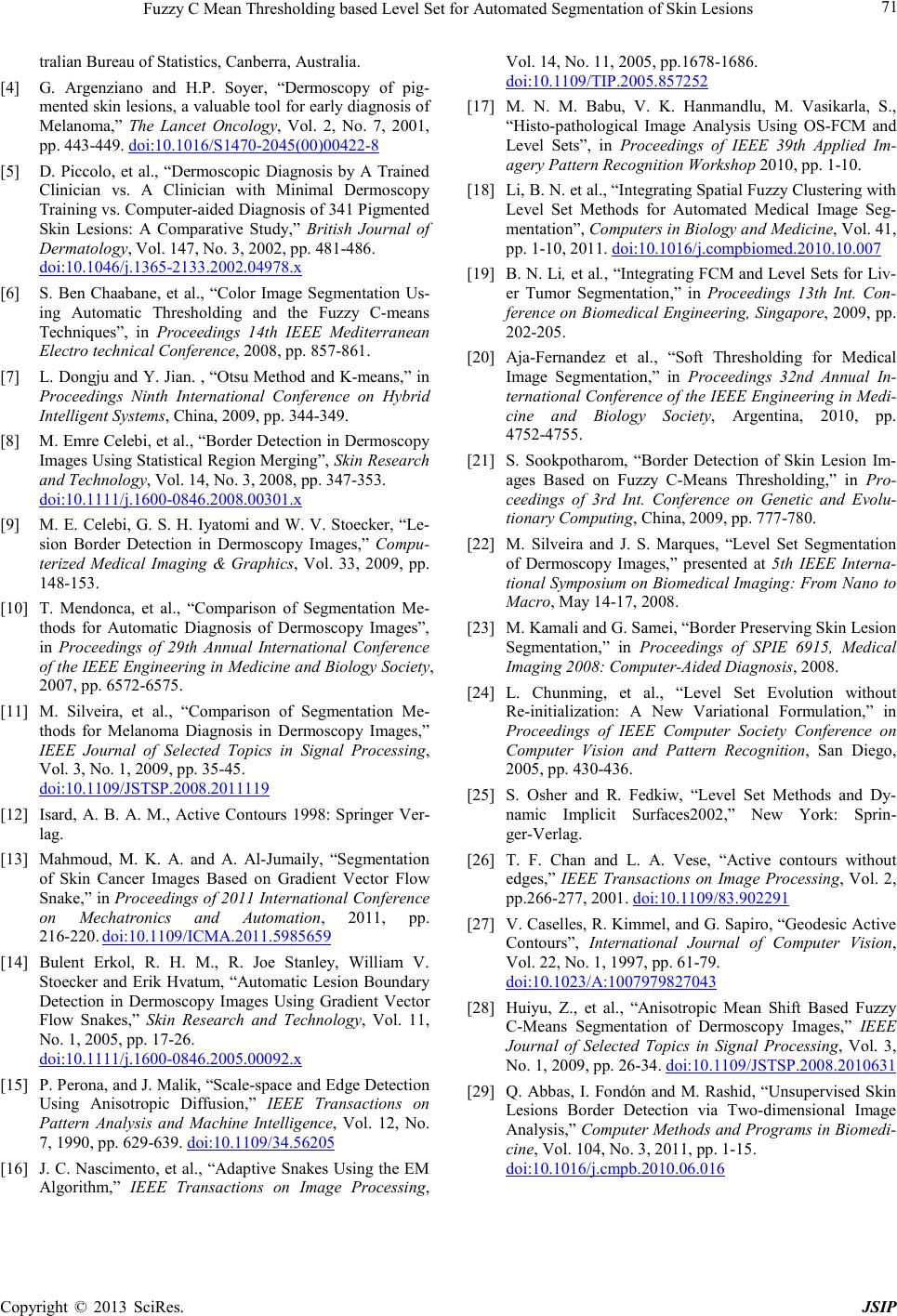
Fuzzy C Mean Thresholding based Level Set for Automated Segmentation of Skin Lesions
Copyright © 2013 SciRes. JSIP
tralian Bureau of Statistics, Canberra, Austr alia.
[4] G. Argenziano and H.P. Soyer, “Dermoscopy of pig-
mented skin lesions, a valuable tool for early diagnosis of
Melanoma,” The Lancet Oncology, Vol. 2, No. 7, 2001,
pp. 443-449. doi:10.1016/S1470-2045(00)00422-8
[5] D. Piccolo, et al., “Dermoscopic Diagnosis by A Trained
Clinician vs. A Clinician with Minimal Dermoscopy
Trainin g vs. Computer-aided Diagnosis of 341 Pigmented
Skin Lesions: A Comparative Study,” British Journal of
Dermatology, Vol. 147, No. 3, 2002, pp. 481-486.
doi:10.1046/j.1365-2133.2002. 04978.x
[6] S. Ben Chaabane, et al., “Color Image Segmentation Us-
ing Automatic Thresholding and the Fuzzy C-means
Techniques”, in Proceedings 14th IEEE Mediterranean
Electro techn ical Conference, 2008, pp. 857 -861.
[7] L. Dongju and Y. Jian . , “Otsu Me thod and K-means,” in
Proceedings Ninth International Conference on Hybrid
Intelligent Systems, China , 2009, pp. 344-349.
[8] M. Emre Celebi, et al., “Bo rder Detection in Dermoscopy
Images Using Statistical Region Merging”, Skin Resea rch
and Technology, V ol. 14, No. 3, 2008, pp. 347-353.
doi:10.1111/j.1600-0846.2008.00301.x
[9] M. E. Celebi, G. S. H. Iyatomi and W. V. Stoecker, “Le-
sion Border Detection in Dermoscopy Images,” Co mp u-
terized Medical Imaging & Graphics, Vol. 33, 2009, pp.
148-153.
[10] T. Mendonca, et al., “Comparison of Segmentation Me-
thods for Automatic Diagnosis of Dermoscopy Images”,
in Proceedings of 29th Annual International Conference
of the IEEE Engineering in Medicine and Biology Society,
2007, pp . 6572-6575.
[11] M. Silveira, et al., “Comparison of Segmentation Me-
thods for Melanoma Diagnosis in Dermoscopy Images,”
IEEE Journal of Selected Topics in Signal Processing,
Vol. 3, No. 1, 2009, pp. 35-45.
doi:10.1109/JS TSP.2008.20111 19
[12] Isard, A. B. A. M., Active Contours 1998: Springer Ver-
lag.
[13] Mahmoud, M. K. A. and A. Al-Jumaily, “Segmentation
of Skin Cancer Images Based on Gradient Vector Flow
Snake,” in Proceedings of 2011 International Conference
on Mechatronics and Automation, 2011, pp.
216-220. doi:10.1109/IC MA.2011.59 85659
[14] Bulent Erkol, R. H. M., R. Joe Stanley, William V.
Stoecker and Erik Hvatum, “Automatic Lesion Boundary
Detection in Dermoscopy Images Using Gradient Vector
Flow Sn akes,” Skin Research and Technology, Vol. 11,
No. 1, 2005, pp. 17-26.
doi:10.1111/j.1600-0846.2005.00092.x
[15] P. Perona, an d J. Mali k, “Scale-sp ace and Edge Detection
Using Anisotropic Diffusion,” IEEE Transactions on
Pattern Analysis and Machine Intelligence, Vol. 12, No.
7, 1990, pp. 629-639. doi:10.1109/34.56205
[16] J. C. Nascimento , et al., “Adaptive Snakes Using the EM
Algorithm,” IEEE Transactions on Image Processing,
Vol. 14, N o. 11, 2005, pp.1678-1686.
doi:10.1109/TIP.2005.85 7252
[17] M. N. M. Babu, V. K. Hanmandlu, M. Vasikarla, S.,
“Histo-pathological Image Analysis Using OS-FCM and
Level Sets”, in Proceedings of IEEE 39th Applied Im-
agery Pattern Recognition Workshop 201 0, pp. 1-10.
[18] Li, B . N. et al., “Integrating Spatial Fuzzy Clustering with
Level Set Methods for Automated Medical Image Seg-
mentati o n”, Computers in Biology and Medicine, Vol. 41,
pp. 1-10, 2011. doi:10.1016/j.compbiomed.2010.10.007
[19] B. N. Li , et al., “Integrati ng FCM and Level Sets for Liv-
er Tumor Segmentation,” in Proceedings 13th Int. Con-
ference on Biomedical Engineering, Singapore, 2009 , pp.
202-205.
[20] Aja-Fernandez et al., “Soft Thresholding for Medical
Image Segmentation,” in Proceedings 32nd Annual In-
ternational Conference of the IEEE Engineering in Medi-
cine and Biology Society, Argentina, 2010, pp.
4752-4755.
[21] S. Sookpotharom, “Border Detection of Skin Lesion Im-
ages Based on Fuzzy C-Means Thresholding,” in Pro-
ceedings of 3rd Int. Conference on Genetic and Evolu-
tionary Computing, Chi na , 2009, pp. 777-780.
[22] M. Silveira and J. S. Marques, “Level Set Segmentation
of Dermoscopy Images,” presented at 5th IEEE Interna-
tional Symposium on Biomedical Imaging: From Nano to
Macro, May 14-1 7, 2008.
[23] M. Kamali and G. Samei, “Border Preserving Skin Lesion
Segmentation,” in Proceedings of SPIE 6915, Medical
Imagi ng 2008: Comp ut e r -A ided D iagnosis , 20 08.
[24] L. Chunming, et al., “Level Set Evolution without
Re-initialization: A New Variational Formulation,” in
Proceedings of IEEE Computer Society Conference on
Computer Vision and Pattern Recognition, San Diego,
2005, pp . 430-436.
[25] S. Osher and R. Fedkiw, “Level Set Methods and Dy-
namic Implicit Surfaces2002,” New York: Sprin-
ger-Ver l ag.
[26] T. F. Chan and L. A. Vese, “Active contours without
edges,” IEEE Transactions on Image Processing, Vol. 2,
pp.266-277, 2001. doi:10.1109/83.902291
[27] V. Caselles, R. Kimmel, and G. Sapiro , “Geodesi c Active
Contours”, International Journal of Computer Vision,
Vol. 22, No. 1, 1997, pp. 61-79.
doi:10.1023/A:1007979827043
[28] Huiyu, Z., et al., “Anisotropic Mean Shift Based Fuzzy
C-Means Segmentation of Dermoscopy Images,” IEEE
Journal of Selected Topics in Signal Processing, Vol. 3,
No. 1, 2009 , pp. 26-34. doi:10.1109/JSTSP.2008.2010631
[29] Q. Abbas, I. Fondón and M. Rashid, “Unsupervised Skin
Lesions Border Detection via Two-dimensional Image
Analysis,” Computer Methods and Programs in Biomedi-
cine, Vol. 104, No. 3, 2011, pp. 1-15.
doi:10.1016/j.cmpb.2010.06.016